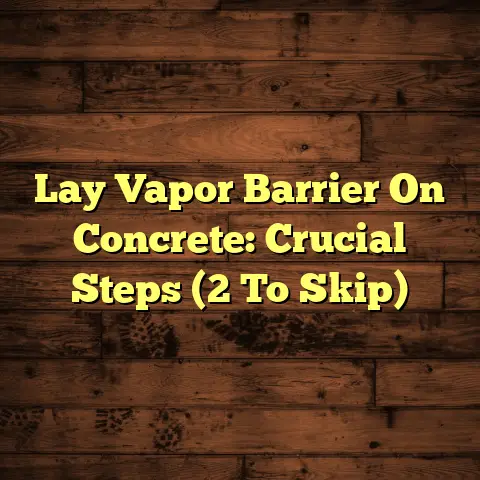Quality Flooring Matters! (5 Mistakes Costly!)
And let me tell you, flooring is more than just something to walk on. It’s the foundation of your space, impacting everything from aesthetics to functionality and even your property value.
Think about it: Your floors are the backdrop to your life, the stage for your family memories, and the first impression you make on guests or customers.
But here’s the kicker: Many homeowners and business owners prioritize upfront cost over long-term quality. I get it; budgets are real. But trust me, that short-term “saving” can lead to some serious headaches (and expenses!) down the road.
That’s why I’m here to spill the beans on five common, costly mistakes I see people make all the time when choosing or installing flooring. We’ll start with one of the most tempting traps: the allure of easy installation. So, let’s dive in!
The Importance of Ease of Installation
Let’s face it, the idea of a quick and easy flooring project is super appealing. Who wants to spend weeks tearing up old floors and wrestling with new ones?
Ease of installation isn’t just about convenience; it directly impacts your project’s overall cost and timeline.
Think about it: the faster the install, the less you’re paying in labor costs (if you’re hiring someone) or the less time you’re spending doing it yourself.
Flooring That Plays Nice: Easy Install Options
Certain flooring materials are known for their relatively straightforward installation processes. These can be real lifesavers for DIYers or anyone looking to minimize labor expenses. Some popular options include:
-
Laminate: This stuff clicks together like puzzle pieces. It’s relatively forgiving, making it a good choice for beginners.
-
Vinyl Planks (LVP): LVP comes in click-lock or glue-down varieties. Click-lock is generally easier for DIY, while glue-down requires a bit more finesse.
-
Engineered Hardwood: Similar to laminate, engineered hardwood often features click-lock systems. It gives you the look of real wood with easier installation.
But here’s a word of caution: Even with these “easy” options, proper preparation is key. You still need a level subfloor and careful attention to detail to avoid problems.
DIY vs. Pro: Know Your Limits
Now, let’s talk about DIY versus professional installation. I’m all for saving money where you can, but flooring is one area where cutting corners can seriously backfire.
DIY Pros:
-
Cost Savings: Obvious, right? You save on labor costs.
-
Sense of Accomplishment: There’s nothing like the satisfaction of doing it yourself.
DIY Cons:
-
Time Commitment: Flooring projects can take way longer than you expect.
-
Potential for Mistakes: Improper installation can lead to costly problems.
-
Tool Investment: You might need to buy or rent specialized tools.
Professional Installation Pros:
-
Expertise and Experience: Pros know what they’re doing and can handle unexpected issues.
-
Faster Completion: They can get the job done much quicker than most DIYers.
-
Warranty Protection: Many installers offer warranties on their work.
Professional Installation Cons:
- Higher Cost: Labor costs can add significantly to the overall price.
So, how do you decide? Ask yourself these questions:
- How comfortable are you with DIY projects?
- Do you have the necessary tools and skills?
- How much time do you have to dedicate to the project?
- How critical is a perfect outcome?
If you’re unsure, it’s always best to consult with a professional. They can assess your project and give you an honest opinion about whether DIY is a realistic option.
The Price of Improper Installation
Let me tell you a story: I once had a client who decided to install laminate flooring themselves to save money. They rushed the job, didn’t properly level the subfloor, and ended up with a disaster.
Within months, the floor started warping, gaps appeared between the planks, and the whole thing looked terrible. They ended up having to rip it all out and hire me to do it right the second time around.
The moral of the story? Improper installation can lead to a whole host of problems, including:
-
Warping: Uneven surfaces or moisture can cause flooring to warp.
-
Gaps: Gaps between planks can trap dirt and debris and look unsightly.
-
Uneven Surfaces: This can be a tripping hazard and make the floor feel unstable.
-
Reduced Lifespan: Improperly installed flooring won’t last as long.
-
Voided Warranties: Many flooring manufacturers void their warranties if the flooring isn’t installed by a professional.
Don’t let ease of installation be your only guide. It’s important, but it’s just one piece of the puzzle. Now, let’s move on to the first major mistake I see people make: prioritizing price over quality.
Mistake #1 – Ignoring Quality for Price
Ah, the allure of the bargain bin! We all love a good deal, but when it comes to flooring, chasing the lowest price can be a recipe for disaster.
The misconception that cheaper flooring options are better for the budget is a dangerous one. While the initial cost might be lower, the long-term consequences can be significant.
I’m talking about increased maintenance, frequent repairs, and, ultimately, premature replacement.
The Long-Term Costs of Cheap Flooring
Let’s break it down. Low-quality flooring often means:
- Lower Durability: It scratches, dents, and fades more easily.
- Shorter Lifespan: You’ll be replacing it much sooner than you would with a quality product.
- Higher Maintenance: It requires more frequent cleaning and special care.
- Reduced Home Value: Cheap flooring can detract from the overall look and feel of your home.
Think of it like this: Buying cheap flooring is like buying a cheap car. You might save money upfront, but you’ll likely end up paying more in repairs and maintenance over the long run.
Real-Life Regrets: Case Studies
I’ve seen countless homeowners regret their decision to go with cheap flooring. Here are just a few examples:
-
The Faded Laminate: A client chose a cheap laminate for their living room. Within a year, it started fading in the areas exposed to sunlight. They ended up having to replace the entire floor.
-
The Scratched Vinyl: Another client opted for a low-grade vinyl in their kitchen. Every time they dropped something, it left a permanent scratch. The floor looked worn and damaged within months.
-
The Peeling Engineered Wood: I had a client who installed a cheap engineered wood in their dining room. With in few months, the top layer started peeling away from the core, due to moisture exposure.
These are just a few examples of how choosing cheap flooring can come back to bite you.
Price vs. Quality: Finding the Sweet Spot
So, how do you find the right balance between price and quality? Here’s my advice:
-
Do Your Research: Read reviews, compare different brands, and talk to flooring professionals.
-
Look for Certifications: Look for certifications like FloorScore, which indicates that a product meets certain indoor air quality standards.
-
Consider the Wear Layer: For vinyl and laminate flooring, pay attention to the wear layer thickness. A thicker wear layer will provide better protection against scratches and wear.
-
Don’t Be Afraid to Spend a Little More: Investing in quality flooring is an investment in your home and your peace of mind.
Here’s a table illustrating the difference in quality and lifespan you can expect at different price points for a common flooring type, let’s say, vinyl plank:
| Price Point (per sq ft) | Quality Indicators | Expected Lifespan | Potential Issues |
|---|---|---|---|
| \$1 – \$2 | Thin wear layer (6-12 mil), basic designs, less durable | 5-10 years | Scratches easily, fades quickly, prone to damage |
| \$2 – \$4 | Moderate wear layer (12-20 mil), better designs, more durable | 10-15 years | Moderate scratch resistance, some fading |
| \$4 – \$6+ | Thick wear layer (20+ mil), high-end designs, very durable | 15-25+ years | Excellent scratch and fade resistance |
Remember: The cheapest option isn’t always the most cost-effective in the long run. Think of flooring as a long-term investment and choose quality over price whenever possible.
Mistake #2 – Underestimating Traffic and Usage
Imagine installing plush, delicate carpet in a busy entryway. Sounds like a recipe for disaster, right? That’s because underestimating traffic and usage is a HUGE flooring mistake.
Neglecting to consider how much foot traffic a space receives and how it’s used can lead to poor flooring choices that wear out quickly and look terrible.
Matching Flooring to the Environment
Different flooring materials are suited for different environments. Here’s a quick rundown:
-
Residential vs. Commercial: Commercial spaces require much more durable flooring than residential spaces.
-
High-Traffic Areas: Entryways, hallways, and kitchens need flooring that can withstand a lot of wear and tear.
-
Low-Traffic Areas: Bedrooms and guest rooms can handle more delicate flooring options.
-
Moisture-Prone Areas: Bathrooms, basements, and laundry rooms require waterproof or water-resistant flooring.
Durability Ratings: Decoding the Jargon
Flooring manufacturers often use durability ratings to indicate how well a product can withstand wear and tear. Here are a few common ratings to look for:
-
AC Rating (Abrasion Class): Used for laminate flooring, this rating indicates how resistant the flooring is to abrasion, impact, and staining. AC1 is the lowest rating (suitable for light residential use), while AC5 is the highest (suitable for heavy commercial use).
-
Wear Layer Thickness: For vinyl flooring, the wear layer thickness is a key indicator of durability. A thicker wear layer will provide better protection against scratches and wear.
-
Janka Hardness Scale: Used for hardwood flooring, this scale measures the resistance of the wood to denting and scratching.
-
Stain Resistance: Many flooring types are tested and rated for stain resistance.
Don’t be afraid to ask your flooring retailer about these ratings. They can help you choose a product that’s appropriate for your specific needs.
Expert Advice: Know Your Needs
I always tell my clients to think carefully about how they use their space before choosing flooring. Here are some questions to consider:
- How many people live in your household?
- Do you have pets?
- Do you wear shoes indoors?
- How often do you entertain guests?
- What kind of activities take place in the space?
For example, if you have kids and pets, you’ll want to choose a flooring option that’s durable, scratch-resistant, and easy to clean. If you have allergies, you might want to avoid carpet and opt for a hard surface flooring like tile or vinyl.
The key is to be realistic about your lifestyle and choose flooring that can handle the wear and tear. Don’t choose a delicate, high-maintenance flooring option if you know it’s not going to hold up to your daily life.
Mistake #3 – Overlooking Moisture and Climate Considerations
Imagine installing beautiful hardwood floors in a damp basement. Within months, they’d be warped, buckled, and possibly even moldy. That’s because overlooking moisture and climate considerations is a critical flooring mistake.
Evaluating environmental factors such as humidity, temperature, and moisture exposure is essential when selecting flooring.
Wet vs. Dry: Choosing the Right Flooring
Not all flooring is created equal when it comes to moisture resistance. Here’s a breakdown of which flooring types are best suited for wet and dry areas:
Best for Wet Areas (Bathrooms, Basements, Laundry Rooms):
- Tile: Tile is waterproof and extremely durable.
- Vinyl: Vinyl is water-resistant and comes in a variety of styles.
- Sheet Vinyl: This offers a seamless, waterproof surface.
- Epoxy Flooring: Epoxy is a durable, waterproof option for basements and garages.
Best for Dry Areas (Living Rooms, Bedrooms, Hallways):
- Hardwood: Hardwood is beautiful but susceptible to moisture damage.
- Laminate: Laminate is water-resistant but not waterproof.
- Carpet: Carpet is comfortable but can trap moisture and allergens.
- Engineered Hardwood: More moisture-resistant than hardwood, but still not ideal for wet areas.
Flooring Failures: Moisture Nightmares
I’ve seen firsthand the devastating effects of neglecting moisture considerations. Here are a few examples:
-
Moldy Carpet: A client installed carpet in their basement without a proper moisture barrier. Within months, mold started growing in the carpet, creating a health hazard.
-
Warped Hardwood: Another client installed hardwood floors in their bathroom. The humidity from showers and baths caused the wood to warp and buckle.
-
Peeling Vinyl: I’ve seen cases where moisture seeping up from the subfloor caused vinyl flooring to peel away from the adhesive.
These are just a few examples of how moisture can ruin your flooring.
Assessing Your Environment: Tips and Tricks
Before you choose flooring, take some time to assess your environment. Here are some tips:
- Check for Leaks: Look for any signs of leaks around windows, pipes, and the foundation.
- Test for Moisture: You can use a moisture meter to check the moisture content of your subfloor.
- Consider Humidity Levels: If you live in a humid climate, choose flooring that can withstand high humidity.
- Install a Moisture Barrier: Always install a moisture barrier under flooring in basements and other areas prone to moisture.
If you’re unsure about the moisture levels in your home, consult with a professional. They can help you identify potential problems and recommend the best flooring options for your specific situation.
Mistake #4 – Disregarding the Subfloor
The subfloor: it’s the unsung hero of your flooring system. It’s the foundation upon which your beautiful new floors rest, and if it’s not in good shape, your flooring project is doomed from the start.
Disregarding the subfloor is a critical mistake that can lead to a host of problems, from squeaks and uneven surfaces to a reduced lifespan for your flooring.
Subfloor 101: What You Need to Know
The subfloor is the layer of material that sits directly beneath your finished flooring. It provides a smooth, stable surface for the flooring to be installed on.
Common subfloor types include:
- Plywood: A common and versatile subfloor material.
- OSB (Oriented Strand Board): A cheaper alternative to plywood.
- Concrete: A common subfloor in basements and slab-on-grade homes.
Each flooring type has specific subfloor requirements. For example, hardwood flooring typically requires a plywood or OSB subfloor, while tile can be installed over a concrete subfloor.
Poor Subfloor Prep: Consequences
I’ve seen countless flooring projects ruined by poor subfloor preparation. Here are some common consequences:
- Squeaks: An uneven subfloor can cause the flooring to rub against the subfloor, creating annoying squeaks.
- Uneven Surfaces: If the subfloor isn’t level, the finished flooring will also be uneven.
- Cracked Tiles: An unstable subfloor can cause tiles to crack.
- Reduced Lifespan: An improperly prepared subfloor can shorten the lifespan of your flooring.
Evaluating and Preparing Your Subfloor
Before you install new flooring, take the time to evaluate and prepare your subfloor. Here’s what to do:
- Inspect the Subfloor: Look for any signs of damage, such as cracks, rot, or water stains.
- Check for Levelness: Use a level to check for any uneven areas.
- Clean the Subfloor: Remove any debris, dirt, or old adhesive.
- Make Repairs: Repair any damage to the subfloor before installing new flooring.
- Level the Subfloor: Use a self-leveling compound to level any uneven areas.
- Add Underlayment: Install an underlayment to provide a smooth, cushioned surface for the flooring.
If you’re not comfortable evaluating and preparing your subfloor yourself, hire a professional. It’s worth the investment to ensure that your flooring project is a success.
Mistake #5 – Skipping Professional Consultation
Choosing the right flooring can feel overwhelming. With so many options, factors to consider, and potential pitfalls, it’s easy to make a mistake. That’s where a professional consultation comes in.
Skipping professional consultation can lead to costly mistakes and a flooring project that doesn’t meet your needs or expectations.
The Benefits of Expert Advice
Consulting with a flooring professional or specialist before making a decision can save you time, money, and headaches. Here are some of the benefits:
- Needs Assessment: A professional can help you assess your needs and recommend the best flooring options for your specific situation.
- Material Recommendations: They can guide you through the vast array of flooring materials and help you choose the right one for your lifestyle, budget, and aesthetic preferences.
- Installation Services: Professionals can provide expert installation services, ensuring that your flooring is installed correctly and will last for years to come.
- Problem Solving: They can identify and address potential problems before they become major issues.
Costly Mistakes: Learning from Others
I’ve seen countless homeowners make costly mistakes because they didn’t seek professional advice. Here’s one example:
- The Wrong Underlayment: A client chose the wrong underlayment for their laminate flooring, resulting in a noisy, uncomfortable floor. They ended up having to rip it all out and start over.
Investment, Not Expense
I encourage you to consider professional consultations as an investment rather than an expense. The cost of a consultation is minimal compared to the cost of making a mistake that you’ll have to live with for years to come.
Don’t be afraid to ask for help. A flooring professional can be your best ally in ensuring a successful flooring project.
Conclusion
Choosing the right flooring is a big decision. It’s an investment in your home, your comfort, and your lifestyle. By avoiding these five common mistakes, you can ensure that your flooring project is a success.
Remember:
- Prioritize quality over price.
- Consider traffic and usage.
- Account for moisture and climate.
- Prepare the subfloor properly.
- Seek professional advice.
Take your time, do your research, and choose wisely. With a little planning and effort, you can create a beautiful and functional space that you’ll enjoy for years to come.





